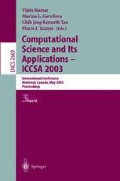Abstract
Automatic computation of best views of objects is very useful. For example, they can be used as the starting point of a scene exploration, or to enrich galleries of objects available through Internet by adding an image a model that may help to decide if it is worth downloading. To select the most interesting viewpoint of an object, we use the so-called viewpoint entropy. The best view is the one which gives the most information of the object being inspected. In this paper we present an adaptive method to compute best views. Our adaptive scheme allows to improve over previous approaches the time of the selection of best views by an order of magnitude, and achieve a nearly interactive rate.
Access this chapter
Tax calculation will be finalised at checkout
Purchases are for personal use only
Preview
Unable to display preview. Download preview PDF.
References
C. Colin. Automatic computation of a scene’s good views. In Proc. MICAD, February 1990.
T. Kamada and S. Kawai. A simple method for computing general position in displaying three-dimensional objects. Computer Vision, Graphics, and Image Processing, 41(1):43–56, January 1988.
P. Barral, G. Dorme, and D. Plemenos. Scene understanding techniques using a virtual camera. In A. de Sousa and J.C. Torres, editors, Proc. Eurographics’00, short presentations, 2000.
D. Plemenos and M. Benayada. Intelligent display in scene modeling. new technique to automatically compute good views. In Proc. International Conference GRAPHICON’96, July 1996.
G. Dorme. Study and implementation of 3D scenes comprehension techniques. PhD thesis, Université de Limoges, 2001. In French.
E. Marchand and N. Courty. Image-based virtual camera motion strategies. In P. Poulin S. Fels, editor, Proc.of the Graphics Interface Conference, GI2000, pages 69–76, Montreal, Quebec, May 2000. Morgan Kaufmann.
E. Bourque and G. Dudek. Automatic creation of image-based virtual reality. In Sensor Fusion and Decentralized Control in Autonomous Robotic Systems, volume 3209, pages 292–303, Bellingham, WA, October 1997. SPIE-The International Society for Optical Engineering. ISBN 0819426415.
L. Wong, C. Dumont, and M. Abidi. Next best view system in a 3-d object modeling task. In Proc. International Symposium on Computational Intelligence in Robotics and Automation (CIRA), pages 306–311, 1999.
W. T. Freeman. Exploiting the generic view assumption to estimate scene parameters. In Proc. 4th International Conference on Computer Vision, pages 347–356, Berlin, Germany, 1993. IEEE.
A. L. Yuille, J. M. Coughlan, and S. Konishi. The generic viewpoint constraint resolves the generalized bas relief ambiguity. In Proc. of Conference on Information Scienes and Systems (CISS 2000), Princeton University, March 15–17 2000.
J. Marks, B. Andalman, P. A. Beardsley, W. Freeman, S. Gibson, J. Hodgins, T. Kang, B. Mirtich, H. Pfister, W. Ruml, K. Ryall, J. Seims, and S. Shieber. Design galleries: A general approach to setting parameters for computer graphics and animation. In T. Whitted, editor, SIGGRAPH 97 Conference Proceedings, Annual Conference Series, pages 389–400. ACM SIGGRAPH, Addison Wesley, August 1997. ISBN 0-89791-896-7.
P.-P. Vázquez, M. Feixas, M. Sbert, and W. Heidrich. Viewpoint selection using viewpoint entropy. In T. Ertl, B. Girod, G. Greiner H. Niemann, and H.-P. Seidel, editors, Proceedings of the Vision Modeling and Visualization Conference (VMV-01), pages 273–280, Stuttgart, November 21–23 2001. IOS Press, Amsterdam.
T. M. Cover and J. A. Thomas. Elements of Information Theory. Wiley, 1991.
S. Gumhold. Maximum entropy light source placement. In Proc. of the Visualization 2002 Conference, pages 275–282. IEEE Computer Society Press, October 2002.
Author information
Authors and Affiliations
Editor information
Editors and Affiliations
Rights and permissions
Copyright information
© 2003 Springer-Verlag Berlin Heidelberg
About this paper
Cite this paper
Vázquez, PP., Sbert, M. (2003). Fast Adaptive Selection of Best Views. In: Kumar, V., Gavrilova, M.L., Tan, C.J.K., L’Ecuyer, P. (eds) Computational Science and Its Applications — ICCSA 2003. ICCSA 2003. Lecture Notes in Computer Science, vol 2669. Springer, Berlin, Heidelberg. https://doi.org/10.1007/3-540-44842-X_31
Download citation
DOI: https://doi.org/10.1007/3-540-44842-X_31
Published:
Publisher Name: Springer, Berlin, Heidelberg
Print ISBN: 978-3-540-40156-8
Online ISBN: 978-3-540-44842-6
eBook Packages: Springer Book Archive

